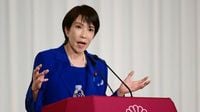Japan’s political landscape shifted dramatically on October 4, 2025, as Sanae Takaichi emerged victorious in the Liberal Democratic Party’s (LDP) leadership race, positioning herself to become the country’s first female prime minister. The moment was marked by both celebration and cautious optimism, with reactions pouring in from across Japan’s political, business, and financial sectors. According to Reuters, Takaichi’s win was fueled by strong support from rank-and-file party members and the influential backing of former Prime Minister Taro Aso, signaling a return to more traditional conservative values within the LDP.
Party General Secretary To Lam of Vietnam was quick to extend congratulations, sending a message to Takaichi acknowledging her historic achievement. The Ministry of Foreign Affairs confirmed the gesture, highlighting the international significance of Takaichi’s ascent to power.
Takaichi, a former internal affairs minister and a self-described conservative nationalist, is expected to replace outgoing Prime Minister Shigeru Ishiba. Her policy platform centers on an expansionary economic agenda, echoing elements of ‘Abenomics’—the economic policies championed by former Prime Minister Shinzo Abe—but with her own twist. She has advocated for what she calls a “responsible proactive fiscal policy,” which includes the possibility of issuing deficit-financing bonds. This approach has sparked debate among economists and political commentators about the balance between fiscal discipline and economic growth.
Tomohisa Ishikawa, chief economist at the Japan Research Institute, weighed in on the challenges ahead, stating, “The key issue is whether it’s possible to strike a balance between fiscal reconstruction and economic growth. Since the term ‘responsible’ is included, I hope that attention will be paid to fiscal discipline. That said, she has mentioned that issuing deficit-financing bonds is among the options, and given her stance of ‘inheriting Abenomics,’ we must be cautious about the risk of fiscal expansion.”
Market watchers responded swiftly to Takaichi’s victory. Hiroki Takei, a strategist at Resona Holdings, described the outcome as a “positive surprise for stock prices.” Takei noted that Japanese equities could see short-term gains, especially in sectors such as semiconductors, artificial intelligence, space, defense, and national resilience. “The fact that she is the first female president of the LDP could strongly signal change to investors,” Takei said, adding that foreign investors anticipating structural reforms might drive a moderate long-term uptrend. However, he also cautioned that if the rally is led by short-term players, it could reverse quickly.
On the monetary policy front, Takaichi’s leadership is expected to make it more difficult for the Bank of Japan (BOJ) to raise interest rates in the near term. Shigenobu Tamura, a political commentator in Tokyo, observed, “With Takaichi’s victory, it is expected that the outlook for BOJ rate hikes will be dampened. As the party’s personnel appointments and potential coalition with opposition parties become clearer, fiscal policy will likely be reassessed.”
Financial analysts echoed these sentiments. Mari Iwashita, executive rates strategist at Nomura Securities, remarked, “Takaichi’s win will make it even more likely the BOJ will take a wait-and-see mode and hold off raising rates in October. Until the political dust settles and there is more clarity on the new administration’s policy stance, there’s little reason for the BOJ to rock the boat with a rate hike.” Naoya Hasegawa, chief bond strategist at Okasan Securities, predicted, “The market saw a more than 60% chance for the BOJ’s rate hike to 0.75% until now, but that will fall to below 50% next week.”
Beyond economics, Takaichi’s leadership is expected to influence Japan’s domestic politics and foreign policy. Yoshinobu Tsutsui, chair of the influential business lobby Keidanren, expressed hope that Takaichi’s experience would help the LDP “unite and, together with its coalition partner Komeito, swiftly establish a stable political framework capable of steadily advancing key policies.” These policies include tax, fiscal, and welfare system reform, labor market changes, and energy security—areas where Japan faces pressing challenges.
Takaichi’s election also carries symbolic weight, both at home and abroad. Shigenobu Tamura noted, “The birth of Japan’s first female prime minister is a very welcome development and will be highly regarded internationally. I also expect that Takaichi will be able to win back the support of the solid conservative base that the LDP lost in lower house and upper house elections.” The international community, particularly Western nations, is expected to welcome her historic rise, though her hawkish stance on foreign policy may raise concerns among Asian neighbors. Yuka Hayashi, vice president at The Asia Group in Washington, D.C., pointed out that Takaichi’s “Japan First” policy aligns with the “America First” approach of U.S. President Donald Trump, potentially setting the stage for a strong bilateral relationship. However, Hayashi cautioned that Takaichi’s hardline positions on World War II legacy issues and her repeated visits to the Yasukuni Shrine could inflame tensions with South Korea and China.
Political alliances will be crucial for Takaichi as she seeks to implement her agenda. The LDP remains a minority in both houses of the Diet, making coalition-building essential. Several commentators, including Tamura and Takei, suggested that the Democratic Party for the People is the most likely partner due to policy alignment. Takahide Kiuchi, executive economist at Nomura Research Institute, explained, “To expand its coalition under Takaichi, the LDP would likely look to parties with similar policy positions. The Sanseito party is ideologically close, but a coalition with them wouldn’t help secure a majority in the lower house. Realistically, the Democratic Party for the People may be the most viable partner.”
Despite the optimism, skepticism lingers regarding Takaichi’s ability to manage the administration and deliver on her promises. Kazutaka Maeda, an economist at Meiji Yasuda Research Institute, observed, “There is skepticism surrounding Takaichi’s ability to manage the administration effectively.” Maeda also noted that while Takaichi toned down some of her more radical proposals during the leadership race, such as cutting the consumption tax, she may revive them in response to opposition demands, potentially leading to higher interest rates, a weaker yen, and accelerated inflation.
As Japan prepares for this new chapter, the world will be watching closely. Takaichi’s policies, leadership style, and ability to navigate both domestic and international challenges will shape not only the future of the LDP but also Japan’s standing on the global stage.




